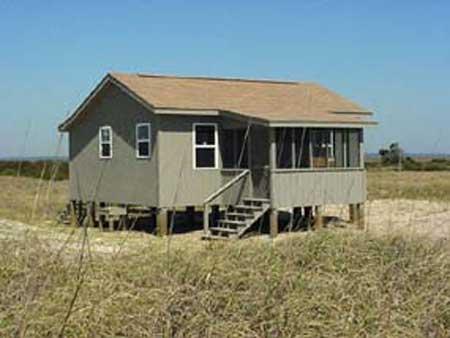Cape Lookout National Seashore in North Carolina offers a historic lighthouse, birding, fishing, miles of beaches, wild horses, shell collecting and other delights. If you'd like to spend the night on an island in the park and prefer not to camp, reservations for cabins are being taken beginning today for the 2010 season.
Cabins are available at two locations in the park, and here's important information to save you some time: Phone numbers for reservation requests have changed from last year and there's a separate number for each of the cabin locations. Requests are accepted only between 9:00 a.m. and 2:00 p.m. Monday through Friday (Eastern Time) and reservations can only be made by phone, beginning on Monday, January 11.
The term "beach cabins" covers quite a range of accommodations, and as the following descriptions of the cabins indicate, these aren't fancy condos. Cape Lookout is a good choice for those who'd like a beach experience that's quite a bit more rustic than many places on the Atlantic coast these days, and you won't find resorts and fine dining here. The park website notes,
Unlike neighboring beaches, no bridges cross from the mainland to the islands. A boat ride is a must for reaching the area—either your own boat or a ferry. There are also no paved roads, concession stands, bathhouses, camp stores or trash cans in the seashore. Except for the ferry landing areas, the islands are undeveloped and wild.
The Great Island Cabins, South Core Banks:
There are 21 individual, rustic cabins that vary in age and condition. Cabins sleep from four to twelve persons in bunk-bed style. Some cabins have screened porches. Most are wired for generator use. Visitors supply their own generator. Each cabin has a hot water heater, table, chairs, and a kitchen with cabinets, propane oven/stove combination and a private bath. Visitors need to provide their own linens, bedding and cookware.
Rates for the Great Island cabins are available here.
The cabins at Great Island will be open from Friday, March 26, 2010 until December 3, 2010. Reservations for the Great Island cabins can be made by calling (252) 728-0942 from 9:00 a.m. to 2:00 p.m., Monday through Friday.
Long Point Cabins, North Core Banks
There are twenty units with a sleeping capacity of six bunk-bed style. Each unit has a hot water heater, individual propane heating system, lighting fixtures, a combination sleeping-eating area with ceiling fans, table, chairs, a kitchen with cabinets, oven/stove combination and a private bath. Each unit is approximately 500 sq. ft. Visitors need to provide their own linens, bedding and cookware.Duplex cabins share porches and decks.
Rates for the Long Point cabins are available at this link.
The Long Point cabins will be open from March 26 until November 28, 2010. Reservations for the Long Point cabins can be made by calling (252) 728-0958, from 9:00 a.m. to 2:00 p.m., Monday through Friday.
Aren't familiar with the area? Click here for a map of the park that shows the locations of the cabins and other key facilities.
If you're accustomed to the large, all-weather ferries in places like Alaska, Washington State and even New York Harbor, be aware that the vessels serving Cape Lookout are quite a bit smaller.
Getting to Cape Lookout National Seashore can be an adventure! Several styles and sizes of boats are used as ferries with 16 passenger flat bottom skiffs predominating. Passengers are generally delivered directly onto the sound-side beach. The larger ferries, some carrying up to 80 passengers, make use of the docks. All are open to the elements. On windy or rainy days be prepared to get wet.
A few of the ferries carry both passengers and vehicles, other carry only passengers, so check the details to make sure the boat you choose will meet your needs!
You'll find a list of authorized ferry services at this link, and first-time visitors should also check the park website for additional information to help plan a visit. The "Things to Know Before You Come" page summarizes some key details.
How do you get around once you reach the islands? According to the park,
Most people arrive at the seashore through one of the passenger ferry services. They then walk to where they wish to go. Near the lighthouse a boardwalk makes the journey from the ferry dock to the beach a little easier.
A 4-wheel drive vehicle makes searching for that good shelling, surf-fishing or camping spot a little easier. If you don't have your own check with the ferry services for details on the beach shuttles.
Boats are another obvious means of travel around this park. You'll find some information about using watercraft at this link.
Still interested? If you want to stay overnight, a cabin offers an option to camping. Just plan ahead, and keep in mind that "bright lights" on these beaches are most likely to be the moon and stars!




Add comment